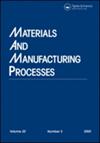Use of additive manufacturing for the fabrication of cellular and lattice materials: a review
IF 4.1
2区 材料科学
Q2 ENGINEERING, MANUFACTURING
引用次数: 42
Abstract
ABSTRACT Complex structures with a prescribed distribution of material often reach the limit of manufacturing technologies. Additive manufacturing has emerged as a valuable option to fabricate structured materials, i.e. cellular or lattice materials. Numerous works related to such materials have used additive manufacturing including extruder-based technologies and laser-based technologies, among others. Each technique results in advantages and disadvantages. Consequently, a review of the different additive-manufacturing technologies used to fabricate cellular and lattice materials is presented here, summarizing the applicability and limitations of each technique. The techniques are categorized according to the state of the raw material they use filament, fluid, and powder. Additionally, guidance on the use of each is given to benefit the fabrication of structured materials.使用增材制造制造细胞和晶格材料:综述
具有规定材料分布的复杂结构往往达到制造技术的极限。增材制造已成为制造结构化材料(即蜂窝或晶格材料)的一种有价值的选择。与这种材料相关的许多工作都使用了增材制造,包括基于挤出机的技术和基于激光的技术等。每种技术都有优点和缺点。因此,本文对用于制造蜂窝和晶格材料的不同增材制造技术进行了综述,总结了每种技术的适用性和局限性。这些技术根据原材料的状态进行分类,它们使用细丝、流体和粉末。此外,还提供了每种材料的使用指南,以利于结构化材料的制造。
本文章由计算机程序翻译,如有差异,请以英文原文为准。
求助全文
约1分钟内获得全文
求助全文
来源期刊

Materials and Manufacturing Processes
工程技术-材料科学:综合
CiteScore
9.00
自引率
22.90%
发文量
132
审稿时长
3.4 months
期刊介绍:
Materials and Manufacturing Processes deals with issues that result in better utilization of raw materials and energy, integration of design and manufacturing activities requiring the invention of suitable new manufacturing processes and techniques, unmanned production dependent on efficient and reliable control of various processes including intelligent processing, introduction of new materials in industrial production necessitating new manufacturing process technology, and more. Information is offered in various formats, including research articles, letter reports, review articles, conference papers, applied research, book and conference reviews, and entire issues devoted to symposia.
All submitted manuscripts are subject to initial appraisal by the Editors, and, if found suitable for further consideration, to peer review by independent, anonymous expert referees. All peer review is single blind and submission is online via ScholarOne Manuscripts.
 求助内容:
求助内容: 应助结果提醒方式:
应助结果提醒方式:


